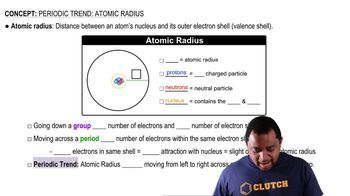Here are the essential concepts you must grasp in order to answer the question correctly.
Atomic Radius
The atomic radius is the distance from the nucleus of an atom to the outermost shell of electrons. In transition metals, the atomic radius is influenced by the number of electron shells and the effective nuclear charge experienced by the outer electrons. As you move down a group in the periodic table, additional electron shells are added, but the increase in nuclear charge is offset by electron shielding, leading to similar radii.
Recommended video:
Electron Shielding
Electron shielding occurs when inner-shell electrons repel outer-shell electrons, reducing the effective nuclear charge felt by the outer electrons. In transition metals of periods 5 and 6, the presence of d-electrons contributes to this shielding effect. As a result, even though period 6 elements have more protons, the increased shielding from the additional inner electrons leads to similar atomic radii compared to period 5.
Recommended video:
Effective Nuclear Charge (Z_eff)
Effective nuclear charge (Z_eff) is the net positive charge experienced by an electron in a multi-electron atom, accounting for both the total nuclear charge and the shielding effect of other electrons. In transition metals, Z_eff increases down a group, but the increase is not sufficient to significantly alter the atomic radius due to the compensating effects of electron shielding. This results in nearly identical radii for transition metals in periods 5 and 6.
Recommended video:

 Verified step by step guidance
Verified step by step guidance

